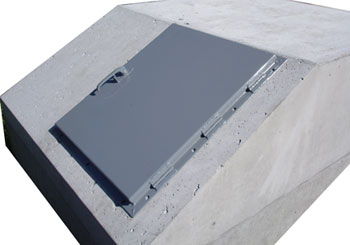Mississippi interest renewed in storm shelters
LaReeca Rucker
The Clarion-Ledger
Kisha Jeanes, her husband and their two young daughters piled into a closet when the bad-weather sirens went off in Benton County. They waited nervously.
Then Jeanes, 36, put Sydnee, 11, and Kaitlyn, 9, in her car and drove through the storm to the county's only community storm shelter, a structure Jeanes said has been around since she was a child.
"It was full of people," she said, "probably 100 to 200."
They were safe, but when the storm cleared last Sunday, numerous homes a mile from her own were destroyed and two people were dead.

"I've been searching on the Internet ... for storm shelters," she said. "You can't put a price on your life."
Many Mississippi residents have a renewed interest in storm shelters following recent back-to-back weekends of tornadoes that left 16 people dead.
FEMA no longer offers hazard mitigation funding that once reimbursed residents in certain areas of the state 75 percent or up to $3,500 for the cost of a storm shelter (or $5,000 for group shelters). But Mississippi Emergency Management Agency representatives say the recent storms could initiate more funding.
Jeff Rent, a MEMA public information officer, said he has received many calls from people inquiring about it.
"When you receive a presidential disaster declaration, one of the things included is hazard mitigation funding," he said. "We've helped provide funding for the installation of 6,749 storm shelters and safe rooms.
"There was a tremendous amount of interest in it, which is why we were able to spend all the money."
Rent said MEMA could receive more.
Larry Meek and his business partner, Tom Root, operate Life-Saver Storm Shelters in Yazoo County. Meek was in Hot Springs when the tornado struck about two miles from his home in the Benton community. He said eight neighbors used his storm shelter while he was gone.
"We've received more calls than usual, and everyone wants to know if they can get some government funding," he said. That funding "let a lot of people get a storm shelter that otherwise couldn't afford one."
Diane West, office manager of Tennessee Storm Shelters, a company that installs storm shelters and safe rooms in Mississippi and surrounding states, sold a shelter to a Mississippi man this week.
"It's not an impulse buy. People have been thinking about getting one, and when it hits close, it becomes a priority," she said.
West said the company typically installs 50-75 shelters and safe rooms a year that cost from $4,295 to $10,000. She encourages customers to comparison shop for a quality shelter that meets or exceeds FEMA standards.
Ernst W. Kiesling, executive director of the National Storm Shelter Association, said some members were in Mississippi this week surveying tornado damage.
"One of their interests is looking at how tornado shelters have performed," he said.
Kiesling said shelters should withstand tornado wind speeds of 250 mph. "That's beyond EF-5, so it's for worse-case scenarios," he said, adding FEMA's grant funding has helped the industry grow.
"Many shelters have been built, and where we're seeing a lot of increase at the moment is in community shelters and public buildings."
Two Mississippi-based architectural firms, JBHM Architects and Eley Guild Hardy Architects, collaborated to design three Gulf Coast schools that serve as FEMA-sanctioned storm shelters, a relatively new practice.
West Harrison, D'Iberville and St. Martin high schools were designed to be self-operational and withstand 200 mph winds. FEMA's Hazard Mitigation Grant Program funded their construction.
"I have heard that Florida is looking into designing all of their future schools with that concept," said architect John Stolarski, project manager for the D'Iberville and West Harrison County High Schools.
The Wayne County School District is building 12 storm shelters at eight campuses at a cost of $7.9 million coming from state and federal funds and the school district.
Rickey Jaggers, Pontotoc County director of emergency management, said following a 2001 tornado that killed six people, injured 35 and caused major damage to 180 homes, many residents had storm shelters built using mitigation funding.
"We have probably 750-800 individual shelters, and we have 39 community shelters," he said. "There are a few of them located in trailer parks and some at churches.
"The town of Ecru - right behind their City Hall - they built five 13-by-13-foot shelters. It looks like a little storm shelter subdivision. Someone said that one night every one of them was full. I guess they got about 50 people in each of them, and there were people standing outside trying to get in. Since then, they've built a couple more."
Jaggers said when funding was available, he received 40-50 calls daily and still gets calls.

